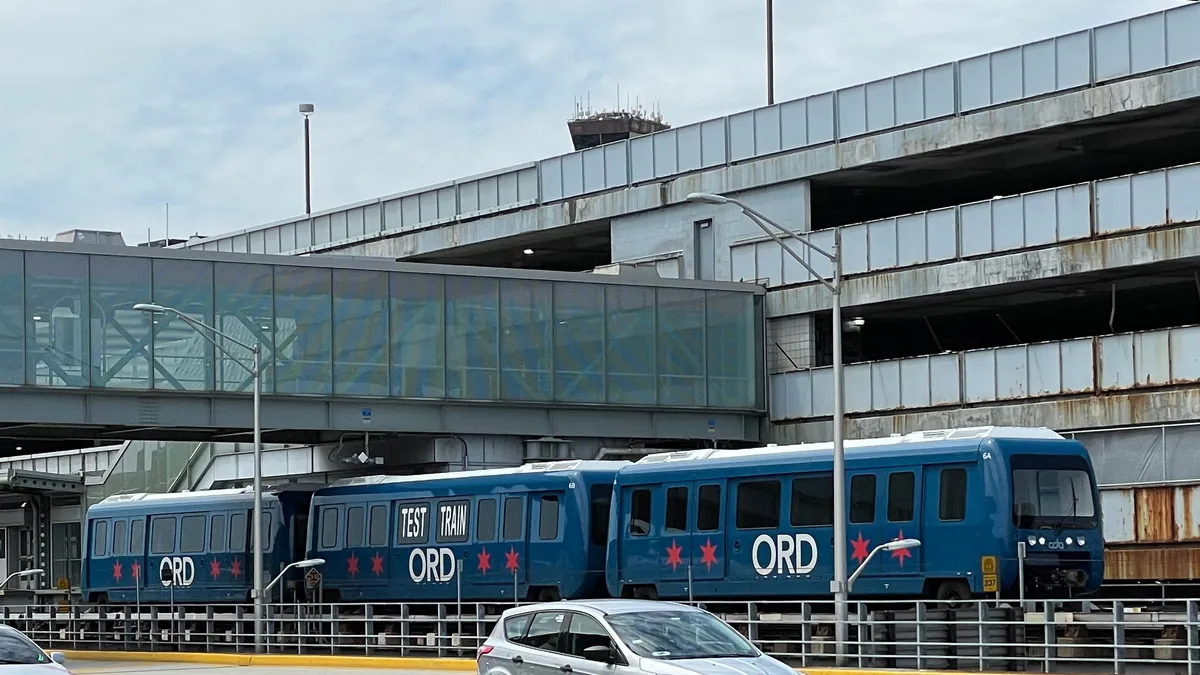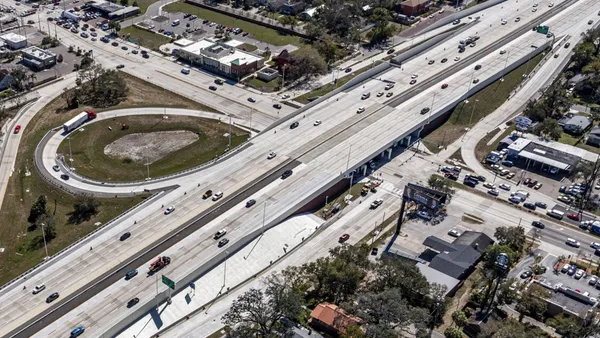Dive Brief:
- After years of prolonged delays, the Airport Transit System is back in the people-moving business at Chicago's O'Hare International Airport, transporting passengers between terminals, parking lots, car rental locations and public transit. The ATS reopened in a limited capacity on Nov. 3, per the Chicago Department of Aviation (CDA).
- Centreville, Virginia-based Parsons Corp. was selected to manage the project, and Montreal, Canada-based Bombadier Transportation supplied the 36-vehicle INNOVIA APM 256 automated people mover (APM) system. The revamped ATS now has double the passenger capacity, better facilities and a renovated automatic train control system, according to the CDA.
- The project, originally slated to open in 2019, has gone over budget and been embroiled in contract disputes. The CDA now expects the ATS to be fully operational early next year.
Dive Insight:
O'Hare was ranked one of the top four busiest U.S. airports in 2019, and 2021 data shows about 978 daily domestic flights traveling to 179 U.S. cities. To accommodate expected growth and make necessary updates, the city embarked on a $8.5 billion umbrella project called ORD 21, with the goal of increasing travel options and gate capacity, improving passenger experience and reducing delays and congestion.
A key part of this is the renovation of the ATS, which has been operating at O'Hare since 1993. It's a driverless transit system that travels back and forth across 2.7 miles of dual-laned track, stopping at terminals and parking stations along the way.
The renovation is slated to add another 2,000 feet of track and build a new station for multi-modal transportation with more space for rental vehicles. The expansion is expected to cut congestion from cars and buses and reduce carbon emissions, according to CDA documents.
The revamped airport train system was originally earmarked at $310 million, though the city has paid $323 million to date. No local and state taxes are being used since the project is part of CDA's capital improvements. Instead, funds are coming from airport bond revenues as well as a $292 million Transportation Infrastructure Finance Innovation Act (TIFIA) loan.
The people mover was supposed to be completed two years ago, so why has it been delayed for so long? It depends on who you ask.
Why the people mover stopped moving
O'Hare's ATS renovation project encountered several roadblocks since work began in 2015, and the system completely shut down in January 2019.
One of the biggest challenges was due to a "mechanical issue during testing," underlined in a 2019 memo from CDA commissioner Jamie Rhee that the Chicago Business Journal obtained. Rhee also pointed to some proprietary technology that required more testing. The CDA has cited the pandemic for delaying the delivery of parts and making it difficult to bring experts to the testing site.
But other reports underscore contract disputes between the city and the project's main contractor, Parsons. The parties eventually took part in a mediated settlement in August 2019, which brought further delays. Meanwhile, the project seems to be over budget by more than $13 million.
When asked about the delays, a spokesperson from Parsons declined to comment.
When Construction Dive reached out to the CDA for comment, a spokesperson pointed us to its fact sheet, which doesn't directly address the reason for the delays but outlines some project challenges. The fact sheet states, "the ATS has been ongoing since 2017 and involved integrating a completely new rail vehicle and control system on the existing track."
It notes that the project is particularly complex because the O'Hare ATS is a unique system, with only one other deployment of its kind in service, in Taipei, Taiwan.
The document adds that the ATS and its vehicles "underwent extensive and rigorous testing, including more than 360,000 total test miles, equivalent to the mileage expected over six months of public service."
The CDA document confirmed that the city of Chicago has paid $323 million to date (about $13 million more than the original $310 million slated for the project), including costs for:
- Design: $19 million
- Guideway (track) extension: $38 million
- Rail vehicle acquisition: $122 million
- Systems modernization and integration: $82 million
- Project management and administration: $62 million
While the limited daily service from 10:30 a.m. to 8:30 p.m. is welcome as holiday travel ramps up, it is still unclear what work remains outstanding and when exactly in early 2022 the ATS will be back to running 24/7.
"We are continuing to work with our contractor, Parsons Construction Group, to make additional technical enhancements to the rail vehicles to support long-term operations and maintenance requirements," a CDA spokesperson wrote in response to questions about remaining work and timelines. "The initial service schedule balances operational demands for ATS service while ensuring system reliability prior to adjusting our existing shuttle bus services."
Bus shuttles will continue to augment service until the ATS is fully operational.













